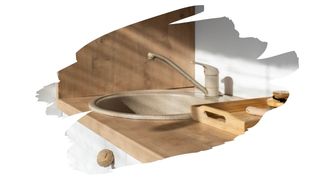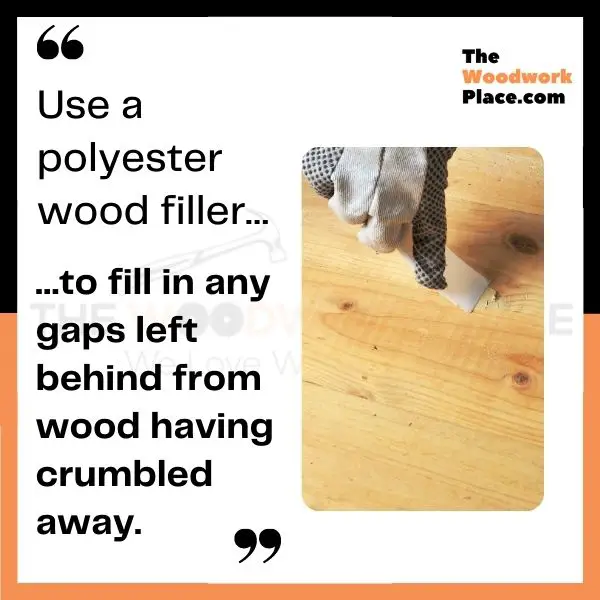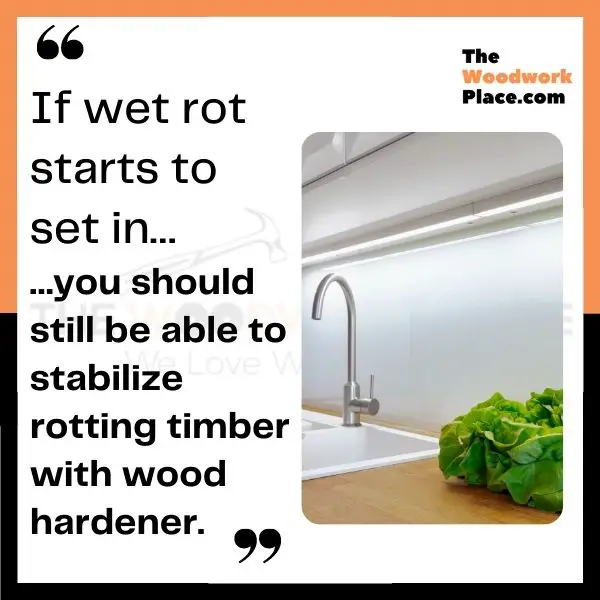Farmhouse sinks are one of the most popular interior design trends over the past decade. This rustic décor kitchen unit is a modern twist on a hundreds-year old style.
But, what do you do when that dream kitchen unit starts to fall apart… literally.
You see, a frequent problem with farmhouse sinks is water damage. Thanks to all of that tap-water splash back, that solid hardwood worktop can easily succumb to mold, rot, and decay.
Related Post: Moldy Wood In A Terrarium? (What You Need To Know)
Now, when it comes to wood that has rotted through, there’s little you can do to save it. Standard practice is to throw it away and replace it completely.
However, what if you don’t want to have to go through the trouble of replacing your whole sink (especially if it was made from expensive solid wood). Is there some way you can save your beautiful rustic sink from all of that growing mold?
Well, in this post, you will learn the top 3 things you can do right now to begin protecting the wooden worktop around your sink. Plus, you will learn what steps you can take to prevent rot from further spreading.

This post may contain affiliate links to products that we receive a commission for (at no additional cost to you). Learn more here.
First Off, Can You Install A Wooden Worktop Around A Kitchen Sink?
If the timber has been pressure treated and waterproofed, then sure, you can install a wooden worktop.
Pressure treated wood refers to lumber that has been infused with chemical wood preservatives. These preservatives help prevent wood rot.
Related Post: How To Dry Pressure Treated Wood (Quickly And Without Warping)
Still, the key requirement that really matters is whether or not that worktop has been properly waterproofed.
Does The Kitchen Worktop Always Need To Be Waterproofed?
Yes, it absolutely does. Fact of the matter is, natural wood (and even manufactured wood types) simply don’t do well around water.
Related Post: Just What Is Manufactured Wood Anyway?
This is because wood soaks up water like a sponge, and will wick away at any humid moisture in the air around it.
And once water starts soaking into those wood fibers, it creates a breeding ground for fungal bacteria to rapidly grow and spread.
Now, there are some types of wood that are naturally rot resistant. For example, Teak wood is filled to the brim with it’s own natural oil. And that oil-overload helps to make this rare timber very water-repellent.
Related Post: Can You Apply Lemon Oil On A Teak Wood Surface?
Other decay-resisting lumber, can be found in Cedar and Oak (which are two wood types popularly used for making farmhouse sinks).
However, what makes these timber types rot resistant doesn’t come from the oils flowing around the sapwood part of the lumber. Instead, it comes from their heartwood. The chemical compound makeup of their heartwood is resistant to decomposition.

Regardless, whether that wood is able to handle decay or not, it will still need to be waterproofed all the same to protect it from daily splashback.
If You Do Nothing, How Long Does It Take For Wood To Rot From Water?
If wood is drenched through daily, then it can begin to rot away in as little as a year.
However, if that kitchen sink is sealed – yet water is somehow able to drip past that sealer – then you can expect significant wood rot to show itself within 3 years.
Related Post: What To Do About Rotting Wood In Your Bathroom
So, How Do You Protect The Wood Behind My Kitchen Sink? Top 3 Tips To Preventing Wood Rot
1). Use A 100% Waterproof Silicone Sealant To Seal The Wooden Worktop
You typical wood finish product won’t be enough. Penetrating oils, polyurethane, lacquer and other wood finishes and sealers aren’t 100% waterproof. They are – at best – fairly water resistant.
Besides, you need a sealer that is not only water-resistant, but is also mold-resistant too.
This is why you need to use a 100% silicone fungal-proof sealer to seal the wood around that kitchen sink.
2). Use A ‘Stretchable’ Sealant
The exact type of silicone sealer you use also matters a lot too.
You see, your typical clear granite countertop sealer product won’t stick and stay on wood. Plus, you need something that can ‘move’ with wood, without cracking.
To put it simply, you need to use what is referred to as a ‘low modulus silicone’ sealer.
And what does ‘low modulus’ mean? Well, basically, it means this silicone is stretchy. While ‘high modulus’ sealers, (like granite sealer products), are more rigid.
And this is an important distinction, especially as high modulus sealers are widely preferred for sealing kitchens and bathrooms.
In the case of a solid marble, porcelain, or granite, these materials don’t shift or move around. So high modulus sealers go well with them.
However, natural wood will expand or contract based on things such as humidity and temperature. And humidity and temperature are two things that’ll shift around a lot as you cook in the kitchen.
So, while low modulus sealers tend to be used mostly to seal windows, you should be using low modulus sealant on the wooden part of your sinks countertop. That is because this stretchy silicone sealer will move around right along with wood (without restricting it too much).
Related Post: Can You Apply A Coat Of Paint Over Wood Hardener?
3). Do Not Use A Penetrating Oil Finish.
The aim of a penetrating oil finish is to soak into wood, and coat those wood fibers with a water-repellent resin.
Now, typically, a mix of oil finish and a top coat sealer (such as polyurethane) can be a great way to protect wood from moisture.
However, an oil finish will make it very difficult for any silicone sealant to stick onto the wooden surface afterwards. So skip those oils.
Related Post: Can You Put Epoxy Over Linseed Oil (For A Longer Lasting Finish)?

But, It’s Too Late For Any Of That! Can Rotting Wood Be Saved?
You can save wood from wet rot.
Of course, this is provided you know exactly what has caused the water damage in the first place (in the case of the sink it’ll be the splash back from the tap).
In which case, you can begin to take steps to halt the spread of that decay in its tracks by stabilizing rotting wood.
Before you begin stabilizing rotting wood, don’t use your kitchen sink for at least 1 week. This is to allow that damp wood time to dry out, before you begin.
How Do You Stabilize Rotting Wood?
You can stabilize and save rotting wood by using wood hardener. But, full disclosure, if the wood is so rotted that it crumbles away in your hand, then a wood hardener won’t be able to do much.
However, if the decay has spread (but the wood hasn’t completely decomposed), then a wood hardener product can restore strength to timber.
A great wood hardener is Minwax’s High Performance Wood Hardener. When you apply it, it’ll soak right down into wood, kind of like an oil finish.
And after a couple hours, that hardener will dry into a very tough substance. And this will preserve the integrity of the wood around the rotted wood sections.
You can check out the latest prices for Minwax’s High Performance Wood Hardener over here on Amazon.

However, wood hardener alone won’t fill in cracks and gaps. You see, when wet wood starts to dry, it can crack and split apart. And these gaps in the surface need to be filled in before you seal them over.
Plus, any sections that have succumbed to crumbling decay will need to be replaced with something. And this is where polyester wood filler comes in.
An all purpose wood filler will pack out the gaps, cracks and missing pieces all around your kitchen sink. And then afterwards it’ll dry into an impenetrable material.
Wood filler can even be sanded and painted over too. Which is a good thing too, because that wood filler may noticeably stand out against the backdrop of natural wood.
Related Post: Wood Filler Showing Through Paint? Fix It In 3 Easy Steps!
One of the most reliable wood fillers on the market comes in the form of Ronseal’s Multipurpose Wood Filler.
You won’t need to wait long for this stuff to dry (it’ll take less than 2 hours). And it’s available in a range of natural wood colors, including Medium Oak and Dark Brown.
You find the latest prices for Ronseal’s Multipurpose Wood Filler over on Amazon too.
What Happens If You Don’t Replace Rotted Wood? The rot will continue to spread, and more of the wood will begin to decompose. And soon enough, you’ll have to replace the whole worktop.
So, Here Are The 3 Key Takeaways…
- Wooden sinks need to be sealed using low modulus 100% silicone sealer.
- But, even if wet rot starts to set in, you should still be able to stabilize rotting timber with wood hardener.
- And use a polyester wood filler to fill in any gaps left behind from wood having crumbled away.

